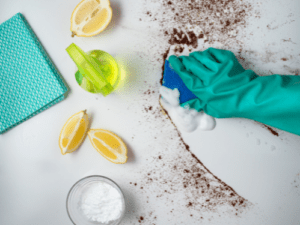Many ingredients in conventional cleaning products may pose environmental and health risks. This guide will help you easily identify sustainable and effective alternatives!
 Better Commercial Products
Better Commercial Products
- Look for reputable certification labels – Check out the Environmental Protection Agency’s (EPA) comprehensive guide on greener cleaning products. Look for “Safer Choice” and “Design for the Environment” certification labels created by the EPA to identify products made with ingredients that are safer for you and the environment. There are other third-party certifications with various goals and standards. The EPA provides a full list of recommendations in regards to private sector standards and eco-labels.
- Use your products to the last drop – Don’t throw a product away until it’s fully empty. Store bottles upside down to get every drop. If you’re at the start of your green cleaning journey, use up what you have left and switch over to sustainable alternatives as you run out.
DIY Cleaning Solutions
- Make your own cleaning products – With a handful of common household ingredients, you can whip up anything from all purpose cleaner to stain remover.
- Reuse containers – Mix the products in an old container and refill them whenever you need.
- Use natural fragrance (or no fragrance at all!) – Essential oils allow you to customize the scent.
- Ditch paper products – Try using rags instead of paper towels. You can also transform old, worn clothes into rags.
Reduce Waste
- Buy in bulk – Bring in your own containers or refill the same containers after an initial purchase, eliminating the waste created from disposable containers. Buying in bulk also allows you to choose exactly how much of an item you need and it’s often cheaper too.
- Shop package-free – There are many products on the market that sell concentrated cleaning supplies, detergent strips/sheets, and other plastic-free products. Many of these products are made with natural ingredients and are lightweight – this reduces the fossil fuels associated with transportation.
- Shop Local – Check out places to shop package-free or in bulk in New York City.
Protect Water and Sewers
- Flush only paper – Be mindful of what goes down your drain. Avoid flushing wipes (even ones labeled “flushable”) and personal hygiene materials, and pouring grease down the drain. This can lead to what they call “fatbergs” – masses of congealed grease and personal hygiene products that linger the sewers and damage wastewater treatment facilities.
Laundry Solutions
- Reduce your load – Wait until you have a full load and make sure to only wash things when they’re actually dirty. Many articles of clothing can be worn more than once before they need to be laundered, and this can extend the life of your clothing as well.
- Wash on cold – Set your washer to a lower temperature (e.g. “Cool”). You’d be surprised how much energy is saved by this simple act.
- Air dry – Use a drying rack or clothesline, especially during the summer months.
- Buy efficient machines – If you have influence over the machines you use, look for an energy efficient (such as an Energy Star) option the next time you buy.
- Use the recommended amount of product (e.g. detergent) – Modern products are incredibly strong and you can often use less than you think and it will get the job done.
